At Your Boxes:
Still more Tree Swallows have arrived. Activity is very frenzied and confusing as individuals and groups of swallows fly from box to box displaying, chasing and calling excitedly. Everything appears unsettled because in fact they aren’t yet settled. The very crucial stage of nest site competition and box claiming has begun.
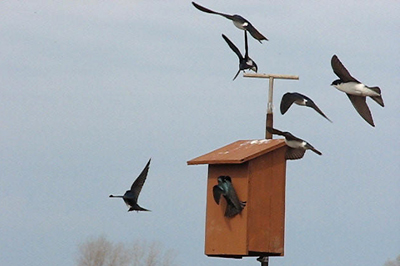
Concepts:
Birds show tremendous diversity placing and building their nests. Your Tree Swallows will nest in boxes, but where would they nest if there weren’t any boxes?
- Almost all nests would be in tree cavities. They always nest in cavities of some sort.
Do Tree Swallows make their own nest cavities?
- No, Tree Swallows are “obligate secondary cavity nesters.” This means they must nest in cavities but can’t make their own. They are totally dependent on cavities made by other creatures or on natural tree holes for nest sites.
- This shortage of nest cavities is one major factor limiting the population size of the Tree Swallow species.
So who does make the nest cavities?
- Under natural conditions Tree Swallows usually use old woodpecker holes or holes in trees where wood has rotted away naturally.
Are there advantages in cavity nesting?
- Cavities may give protection from some predators.
- Cavities may be warmer and drier for eggs and young.
Are there disadvantages in cavity nesting?
- Predators can trap birds inside.
- Secondary cavity nesters lose flexibility, depending on others to furnish a vital resource.
Are there lots of suitable nest holes around?
- No, there usually aren’t enough cavities to go around.
- Due to the normal cavity shortage Tree Swallows can’t always be choosy during nest site competition and box claiming. This is why we sometimes find them trying to nest in what seem to us very odd places.
- Photo below by Karl Overman.
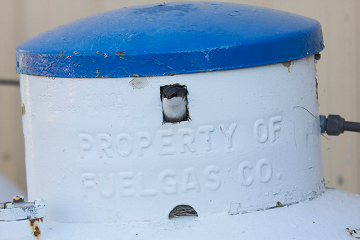
Do Tree Swallows compete with other bird species during nest box claiming?
- Yes, “interspecific competition” for nest cavities is very common.
- Tree Swallows may compete with Bluebirds (see below), House Wrens, chickadees, Purple Martins, owls, kestrels, and some ducks and flycatchers.
- Non-native House Sparrows and Starlings can be severe competitors.
- You’ve designed and placed your boxes to minimize interspecific competition, but you may still see some occur.
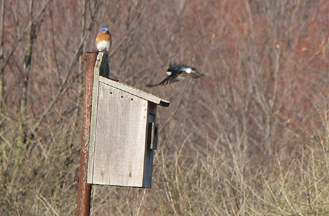
Who are a Tree Swallow’s biggest competitors in nest box claiming apt to be?
- A Tree Swallow’s major foes during nest site competition and box claiming are often other Tree Swallows. This is because because they have identical nesting requirements.
- “Intraspecific competition,” competition with members of one’s own species, is intense for many birds.
- The photo below shows two Tree Swallows fighting for possession of a nest box.

Nest site competition is the main reason Tree Swallows migrate north so early.
- Male Tree Swallows usually arrive first to try to find and claim nest cavities as soon as possible. They need to beat potential competitors, especially other male Tree Swallows, to them if they can.
- Females begin to arrive a few days to a week after the first males.
Intense competition for nest sites is one of a Tree Swallow’s major life issues, for both males and females.
- If a female doesn’t obtain a nest cavity she can’t reproduce. For these short-lived birds missing even one nesting season is a serious failure, so females often compete very aggressively for nest sites.
- Males also compete for sites with other males, but as we’ll see later, males that don’t possess nest cavities may still be able to father young.
Are you noticing intraspecific nest site competition among the swallows during nest box claiming, or are boxes being claimed without a lot of commotion and squabbling?
- You may see a lot of intraspecific competition.
- Tree Swallows perform most of the behaviors described below when box claimers are stimulated by approaching intruders to defend or advertise their boxes.
- Whether a box claimer uses calls, songs, physical displays, chases, or actual fighting to repel intruders varies with individuals, and also by how close an intruder approaches and how determined it is.
- The photo below is by Elinor Schindel.
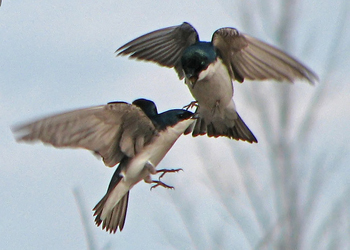
You should see the following nest box claiming behaviors:
- Chatter Call (also called “nest site advertising call”): A loud, rapid monotone chatter. As a swallow makes this call it flattens its body, flutters its wings and aims its head the other swallow. Chatter is normally given by males to other males, and seems to mean “this site is mine, keep away.” When males chatter to females it can mean “this great site is mine, come and see it.”
- Perching at the entrance hole: Guarding or advertising the cavity entrance, often with chattering and wing fluttering.
- Forcing Intruders away from boxes: Not outright chasing, but preventing close approach or landing of other swallows by use of song, call, or threat displays such as bill snapping and gaping open-mouthed (see below).
- Look for all these intraspecific nest site competition behaviors in this video.
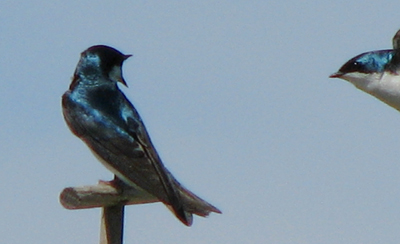
- Chasing Intruders: Rapid flying pursuit of other swallows, attempting to drive them away from a box.
- Fighting: Competition for boxes may escalate. Swallows may fight in mid-air. Battles can include leg grappling, wing beating, gaping, biting and pecking. Combatants sometimes fall to the ground together and continue the struggle there.
- Photo below of two males fighting is from Rick Brown, www.flickr.com/photos/brownjayadventures.
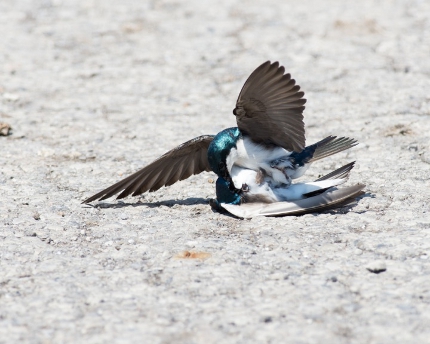
So how are boxes actually claimed?
- It’s confusing to us. It seems like a lot of commotion, but of course the swallows know just what’s happening.
- Somehow the swallows establish nest site ownership through a combination of perching at a site, entering and examining the cavity, advertising it with song and physical display, and expelling persistent competitors by chasing and fighting.
What is a territory?
- A territory is a place, area or resource that one or more animals defend.
- Songbird territories have three main uses: courtship, nesting, and/or feeding.
- A single territory can serve more than one of these three functions.
Are Tree Swallows territorial and, if so, how large is their territory and what does it include?
- Tree Swallows are territorial during the nesting season but they usually defend only their nest cavity plus a relatively small area around it.
- Photo below from Tim van Nus shows a swallow on its territory at the treeless Middleton Island, Alaska, Tree Swallow project.
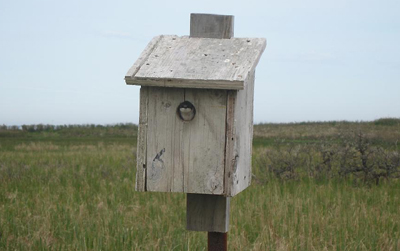
Some songbirds have much larger territories. Why are Tree Swallow territories so small?
- Tree Swallow territories are used just for courtship and nesting. They don’t defend feeding territories around their nests the way many other birds do.
- This fact allows us to space our swallow boxes just 100′ apart.
- In contrast, species like bluebirds must defend enough territory around their nests to supply themselves and their young with food. This is why bluebird boxes should be spaced at least 300′ apart.
Many pairs of Tree Swallows can nest in a relatively small area. Does this mean they are colonial?
- Although some people consider them “semi-colonial,” in nature most Tree Swallow nests are not tightly grouped. They do not form closely-spaced clusters of nests the way Bank Swallows, Cliff Swallows, and Purple Martins do.
Who do you think is doing the chasing and fighting during nest box claiming and territorial defense, male swallows, female swallows, or both?
- Both. Males usually fight other males and females fight other females.
- Remember, females can’t reproduce if they don’t successfully defend their nest cavities from other females.
- Females often fight hard, sometimes even to the death, for chances to nest!
- In the photo below one female has driven another female to the ground and is giving it a severe beating as they struggle for possession of a nest box.
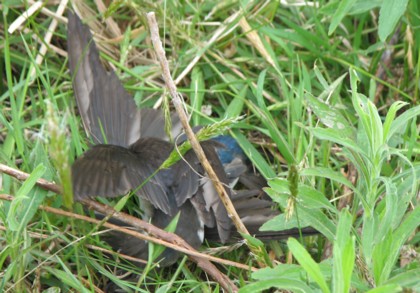
- Battles between female swallows may also occur inside nest boxes. The photo below shows two females removed from inside a box where they were heard fighting.
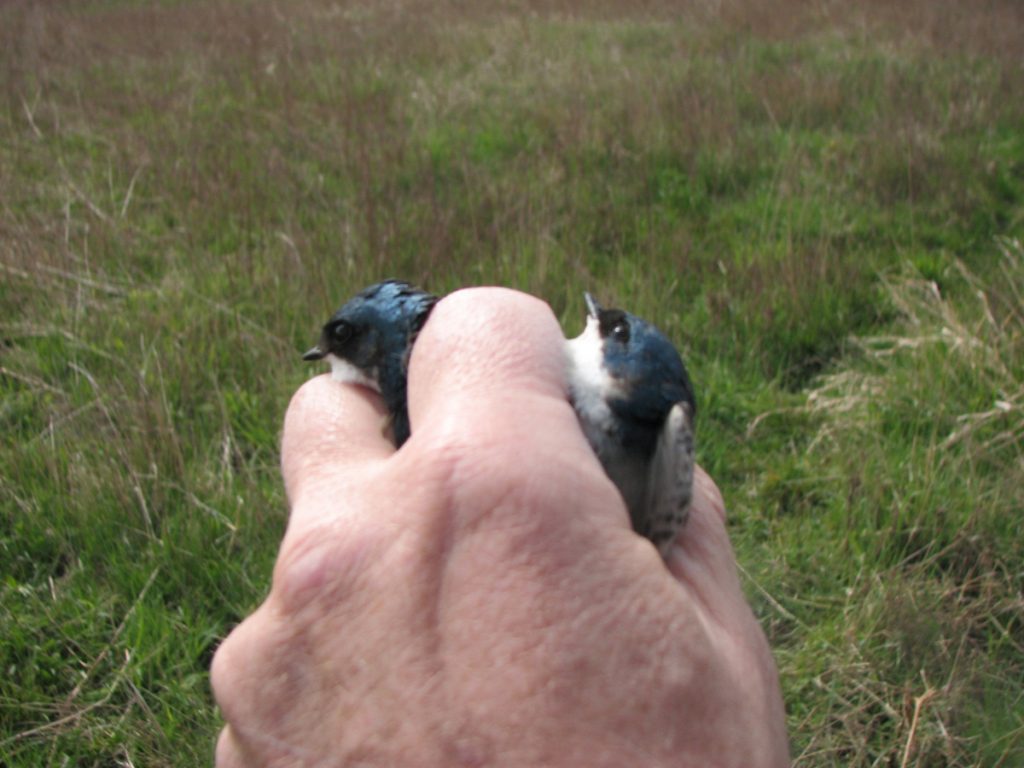
- And here’s a YouTube video from Francois Paquette of Quebec showing just how violent a female versus female box battle can get.
- Male Tree Swallows seldom interfere when females battle over nest sites. It’s probably to their advantage to nest with the winner.
Questions for the next Topic: Tree Swallow Courtship and Pair Formation.
- What does a male Tree Swallow “want” or look for in a female mate?
- What does a female Tree Swallow “want” or look for in a male mate?
- Are there consequences if they make the wrong selection?
———————————————————————————–
Home: Tree Swallow Nest Box Projects
Creating Tree Swallow Nest Box Projects
Spring Return
Nesting Season Behavior
Song and Calls
Nest Site Claiming
Pair Formation
Nest Building
Bird Flight
Mating and Paternity
Diary of One Season at Salmon Creek
Monitoring Nest Boxes and Keeping Records
Making Box Checks Keeping Box Records Control Sheets Season Summaries Print Sheets
Banding Your Tree Swallows Banding Adults Banding Nestlings
Tree Swallows in Research Research Bibliography Glossary of Terms